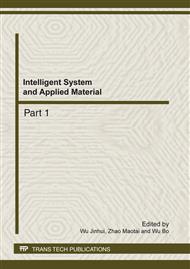p.361
p.366
p.371
p.376
p.381
p.386
p.391
p.396
p.400
Effect of Polyvinylpyrrolidone Ratio on Synthesis of High Concentration Nano-Silver Colloid
Abstract:
Conductive ink, especially the nano-silver ink is becoming more and more popular in printable electronic field. In order to synthesize high concentration, stable nano-silver colloid, liquid chemical reduction is used and different ratios of PVP to silver nitrate are studied. After precise adjustments of the parameters, colloid with silver content of wt7.8% is obtained. Particle size distribution, UV-Vis spectra, thermo gravimetric analysis and SEM images are conducted to characterize the silver particles. The results show that when molar ratio of PVP to silver nitrate is 0.6, the average particle size is 170nm and some deposit can be seen, while the ratio increases to 1.5, the size decreases to 68nm, and the residue quality of the silver colloid showed in the TG analysis is 7.88%. After aging for 1 month, the colloid is still stable and the color keeps to the original dark green. When the ratio continues increasing to 2.5, particle size becomes 112nm and some larger particles beyond 3μm can be observed.
Info:
Periodical:
Pages:
381-385
Citation:
Online since:
February 2012
Authors:
Price:
Сopyright:
© 2012 Trans Tech Publications Ltd. All Rights Reserved
Share:
Citation:


